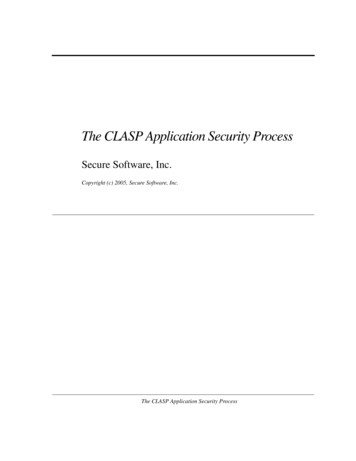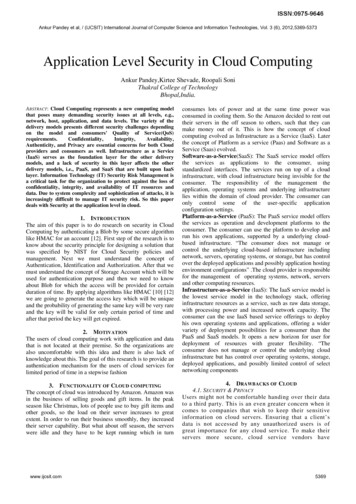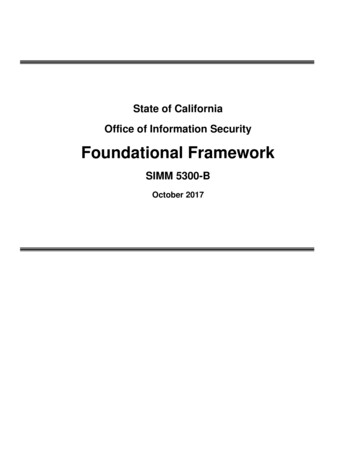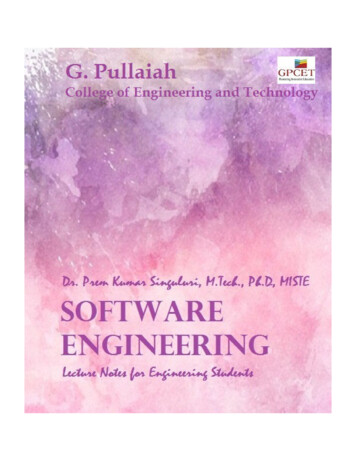
Transcription
The CLASP Application Security ProcessSecure Software, Inc.Copyright (c) 2005, Secure Software, Inc.The CLASP Application Security Process
The CLASP Application Security Process
TABLE OF CONTENTSCHAPTER 1Introduction1CLASP Status 4An Activity-Centric Approach4The CLASP Implementation Guide5The Root-Cause Database 6Supporting MaterialCHAPTER 27Implementation GuideThe CLASP Activities911Institute security awareness program 11Monitor security metrics 12Specify operational environment 13Identify global security policy 14Identify resources and trust boundaries 15Identify user roles and resource capabilities 16Document security-relevant requirements 17Detail misuse cases 18Identify attack surface 19Apply security principles to design 20Research and assess security posture of technology solutions 21Annotate class designs with security properties 22Specify database security configuration 23Perform security analysis of system requirements and design(threat modeling) 24Integrate security analysis into source management process 25Implement interface contracts 26Implement and elaborate resource policies and securitytechnologies 27Address reported security issues 28Perform source-level security review 29Identify, implement and perform security tests 30The CLASP Application Security Processi
Verify security attributes of resources 31Perform code signing 32Build operational security guide 33Manage security issue disclosure process 34Developing a Process Engineering PlanBusiness objectives 35Process milestones 35Process evaluation criteria35Form the Process Engineering TeamSample Roadmaps353638“Green Field” Roadmap 39Legacy Roadmap 40CHAPTER 3Role-based OverviewsProject Manager4141Requirements Specifier 42Architect 43Designer43Implementor44Test Analyst45Security AuditorCHAPTER 4Activities4547Institute security awareness program47Provide security training to all team members 47Promote awareness of the local security setting 48Institute accountability for security issues 48Appoint a project security officer 49Institute rewards for handling of security issues 50Monitor security metrics50Identify metrics to collect 50Identify how metrics will be used 53Institute data collection and reporting strategy 54Periodically collect and evaluate metrics 55Specify operational environmentiiThe CLASP Application Security Process55
Identify requirements and assumptions related to individualhosts 56Identify requirements and assumptions related to networkarchitecture 57Identify global security policy57Build a global project security policy, if necessary 57Determine suitability of global requirements to project 58Identify resources and trust boundaries59Identify network-level design 59Identify data resources 60Identify user roles and resource capabilities61Identify distinct capabilities 61Map system roles to capabilities 61Identify the attacker profile (attacker roles and resources) 62Document security-relevant requirements 63Document explicit business requirements 64Develop functional security requirements 64Explicitly label requirements that denote dependencies 66Determine risk mitigations (compensating controls) for eachresource 67Resolve deficiencies and conflicts between requirement sets 68Detail misuse cases69Identify misuse cases 69Describe misuse cases 70Identify defense mechanisms for misuse cases 70Evaluate results with stakeholders 70Identify attack surface 71Identify system entry points 71Map roles to entry points 72Map resources to entry points 72Apply security principles to design72Refine existing application security profile 72Determine implementation strategy for security services 73Build hardened protocol specifications 74Design hardened interfaces 75Research and assess security posture of technologysolutions 75Get structured technology assessment from vendorPerform security risk assessment 76The CLASP Application Security Process75iii
Receive permission to perform security testing of softwarePerform security testing 7776Annotate class designs with security properties 77Map data elements to resources and capabilities 77Annotate fields with policy information 78Annotate methods with policy data 78Specify database security configurationIdentify candidate configurationValidate configuration 797979Perform security analysis of system requirements and design(threat modeling) 80Develop an understanding of the system 80Determine and validate security-relevant assumptions 80Identify threats on assets/capabilities 82Determine level of risk 83Identify compensating controls 85Evaluate findings 85Integrate security analysis into source managementprocess 86Select analysis technology or technologies 86Determine analysis integration point 86Integrate analysis technology 87Implement interface contracts88Implement validation and error handling on function or methodinputs 88Implement validation on function or method outputs 89Implement and elaborate resource policies and securitytechnologies 89Review specified behavior 89Implement specification 89Address reported security issues90Assign issue to investigator 90Assess likely exposure and impact 90Determine and execute remediation strategiesValidation of remediation 91Perform source-level security reviewScope the engagement 92Run automated analysis tools 93Evaluate tool results 93ivThe CLASP Application Security Process9291
Identify additional risks 93Identify, implement and perform security tests94Identify security tests for individual requirementsIdentify resource-driven security tests 95Identify other relevant security tests 95Implement test plan 95Execute security tests 9594Verify security attributes of resources96Check permissions on all static resources 96Profile resource usage in the operational context 96Perform code signing97Obtain code signing credentials 97Identify signing targets 97Sign identified targets 97Build operational security guide98Document pre-install configuration requirements 98Document application activity 98Document the security architecture 98Document security configuration mechanisms 98Document significant risks and known compensating controls 99Manage security issue disclosure process99Provide means of communication for security issues 99Acknowledge receipt of vulnerability disclosures 100Address the issue internally 101Communicate relevant information to the researcher 101Provide a security advisory and customer access toremediation 102CHAPTER 5Vulnerability Root-Causes103Preliminaries 105Problem types 105Consequences 106Exposure period 106Other recorded information107Range and type errors 108Buffer overflow 108“Write-what-where” condition 110Stack overflow 113The CLASP Application Security Processv
Heap overflow 115Buffer underwrite 117Wrap-around error 118Integer overflow 120Integer coercion error 122Truncation error 124Sign extension error 126Signed to unsigned conversion error 127Unsigned to signed conversion error 130Unchecked array indexing 132Miscalculated null termination 133Improper string length checking 135Covert storage channel 138Failure to account for default case in switch 139Null-pointer dereference 141Using freed memory 143Doubly freeing memory 145Invoking untrusted mobile code 147Cross-site scripting 148Format string problem 149Injection problem (‘data’ used as something else) 151Command injection 153SQL injection 155Deserialization of untrusted data 158Environmental problems160Reliance on data layout 160Relative path library search 161Relying on package-level scope 163Insufficient entropy in PRNG 164Failure of TRNG 165Publicizing of private data when using inner classes 167Trust of system event data 168Resource exhaustion (file descriptor, disk space, sockets, .)Information leak through class cloning 172Information leak through serialization 174Overflow of static internal buffer 175Synchronization and timing errors176State synchronization error 176Covert timing channel 178Symbolic name not mapping to correct object 180Time of check, time of use race condition 181viThe CLASP Application Security Process169
Comparing classes by name 183Race condition in switch 184Race condition in signal handler 186Unsafe function call from a signal handler 188Failure to drop privileges when reasonable 190Race condition in checking for certificate revocation 192Mutable objects passed by reference 193Passing mutable objects to an untrusted method 195Accidental leaking of sensitive information througherror messages 196Accidental leaking of sensitive information through sentdata 198Accidental leaking of sensitive information through dataqueries 199Race condition within a thread 200Reflection attack in an auth protocol 202Capture-replay 204Protocol errors206Failure to follow chain of trust in certificate validation 206Key exchange without entity authentication 208Failure to validate host-specific certificate data 209Failure to validate certificate expiration 211Failure to check for certificate revocation 212Failure to encrypt data 213Failure to add integrity check value 215Failure to check integrity check value 217Use of hard-coded password 219Use of hard-coded cryptographic key 221Storing passwords in a recoverable format 223Trusting self-reported IP address 225Trusting self-reported DNS name 226Using referrer field for authentication 228Using a broken or risky cryptographic algorithm 230Using password systems 232Using single-factor authentication 234Not allowing password aging 235Allowing password aging 237Reusing a nonce, key pair in encryption 238Using a key past its expiration date 240Not using a random IV with CBC mode 241Failure to protect stored data from modification 243The CLASP Application Security Processvii
Failure to provide confidentiality for stored data 245General logic errors 246Ignored function return value 246Missing parameter 247Misinterpreted function return value 249Uninitialized variable 250Duplicate key in associative list (alist) 252Deletion of data-structure sentinel 253Addition of data-structure sentinel 255Use of sizeof() on a pointer type 257Unintentional pointer scaling 258Improper pointer subtraction 259Using the wrong operator 260Assigning instead of comparing 261Comparing instead of assigning 263Incorrect block delimitation 264Omitted break statement 265Improper cleanup on thrown exception 267Improper cleanup on thrown exception 268Uncaught exception 269Improper error handling 271Improper temp file opening 273Guessed or visible temporary file 275Failure to deallocate data 277Non-cryptographic PRNG 278Failure to check whether privileges were droppedsuccessfully 280APPENDIX APrinciples (Key Security Concepts)Insider Threats as the Weak Link283283Ethics in Secure-Software Development284Fundamental Security Goals — Core Security ServicesAuthorization (access control) 285Authentication 286Confidentiality 289Data Integrity 290Availability 290Accountability 291Non-repudiation 291viiiThe CLASP Application Security Process284
Input Validation291Where to perform input validation 292Ways in which data can be invalid 292How to determine input validity 293Actions to perform when invalid data is found 294Assume the Network is Compromised 294Minimize Attack SurfaceSecure by Default296Defense-in-Depth297295Principles for Reducing ExposureAPPENDIX B297The Insecure Bootstrapping Principle298Templates and Worksheets301Sample Coding Guidelines302Instructions to manager 302Instructions to developer 302System Assessment Worksheets310Development Process and Organization 314System Resources 319Network Resource Detail 321File System Usage Detail 322Registry Usage (Microsoft Windows Environment)APPENDIX CGlossary of Terms324327The CLASP Application Security Processix
xThe CLASP Application Security Process
CHAPTER 1IntroductionApplication security is an important emerging requirement in software development. Beyond the potential for severe brand damage, potential financial lossand privacy issues, risk-aware customers such as financial institutions and governmental organizations are looking for ways to assess the security posture ofproducts they build or purchase. In addition, these customers plan to ultimatelyhold vendors accountable for security problems in their software. This problemis further exacerbated by perceived security risks associated with the growingadoption of outsourced development and free/open source software.The largest independent software vendors (ISVs) have begun taking this problem very seriously. In 2002, Microsoft launched an ongoing effort to improvesecurity throughout its development process, which involves training and process improvements. For the first two months of this effort, their entire development staff was forbidden from making changes to any product unless thespecific purpose of the changes was to improve the security. Many other vendors, such as Oracle, have had similarly serious reactions to the issue.Addressing the applications security problem effectively is difficult because traditional software development lifecycles do not deal with these concerns well.This is largely due to a lack of structured guidance, since the few books on thetopic are relatively new and document only collections of best practices.The CLASP Application Security Process1
In addition, security is not a feature that demonstrates well. Development organizations generally prefer to focus on core functionality features and thenaddress security in an ad-hoc manner during development — focusing on providing a minimal set of services and driven by the limited security expertise ofdevelopers. This usually results in over-reliance on poorly understood securitytechnologies.For example, SSL is the most popular means of providing data confidentialityand integrity services for data traversing a network. Yet most SSL deploymentsare susceptible to network-based attacks because the technology is widely misunderstood by those who apply it. Particularly, people tend to treat it as a dropin for traditional sockets, but when used in this way necessary server authentication steps are skipped. Performing proper authentication is usually a highlycomplex process.Organizations that deploy technologies such as SSL and Java are often susceptible to a false sense of security. For example, Secure Software, Inc., conductedan informal study of Java programs which showed that a significant securityrisk appeared, on average, once per thousand lines of code — an extremely highnumber.The result of the traditional shoestring approach to software security is thatorganizations will cross their fingers, hoping that security problems do not manifest and deferring most security issues to the time when they do — which isoften well after the software is deployed. This is the so-called “penetrate-andpatch” model.Bolting on a security solution after a problem is found is, of course, just as nonsensical as adding on a reliability module to fix robustness problems after software is developed. In fact, an IBM study on the cost of addressing securityissues at various points during the SDLC argues that the cost of deferring security issues from design into deployment is greater than the cost associated withtraditional reliability bugs.This is largely due to the tremendous overhead associated with vulnerability disclosure and actual security breaches.CLASP — Comprehensive, Lightweight Application Security Process — provides a well-organized and structured approach for locating security concernsinto the early stages of the software development lifecycle, whenever possible.CLASP is a reflection of six years of work with development teams to addresssecurity issues and incorporates the best practices documented in various books,including Building Secure Software and the Secure Programming Cookbook.2The CLASP Application Security Process
CLASP is a set of process pieces that can be integrated into any software development process. CLASP is designed to be both easy-to-adopt and effective. Ittakes a prescriptive approach, documenting activities that organizations shouldbe performing. CLASP also provides an extensive set of security resources thatmake implementing activities reasonable, particularly when also introducingtools to help automate process pieces.The CLASP method consists of several parts: Chapter 2 is an Implementation Guide that is meant to help organizationsintegrate CLASP process pieces into a development process, based on theneeds of the organization. The Implementation Guide gives an overviewof each CLASP activity. Chapter 3 contains role-based introductions to CLASP. This chapterexplains to project managers at a high level how they should approachsecurity in their job and also introduces the basic responsibilities theyhave. These are meant to be concise introductions that are a starting pointfor employees when they first need to address software security. The CLASP activities are detailed in Chapter 4. Chapter 5 consists of a “root-cause” database. It is a collection of problems in code, including discussions about how they can lead to vulnerabilities in software. There is also advice on avoidance and remediation. In Appendix A, we provide introductions to the most important conceptsthat underlie this process. These concepts are referenced from the rolebased overviews and are relied upon throughout the rest of the process.For example, the third concept in Appendix A discusses the basic securityservices (authorization, authenticating, confidentiality, integrity, availability, accountability, and non-repudiation). Even if the reader has exposure to these services, it is good to examine the CLASP discussion sincethese concepts are relied upon heavily, particularly in requirements definition and analysis. Appendix B provides templates and worksheets for some of the CLASPactivities. For example, we provide an example set of organizationalrequirements, which can also be used as the foundation for a set of product security requirements. Appendix C provides a glossary of terms relevant to application security.The CLASP Application Security Process3
1.1CLASP StatusCLASP is a freely available process. This document details CLASP v1.0. Thisversion was authored primarily by John Viega and Secure Software, Inc., withcontributions from IBM and webMethods (Jeremy Epstein). It has also beeninfluenced heavily by organizations that evaluated early access versions — particularly the Depository Trust and Clearing Corporation.We are interested in feedback as well additional contributors for future versions.Please contact us at clasp@securesoftware.com.1.2An Activity-Centric ApproachAt the core of the CLASP are twenty four new security-related activities thatcan be integrated into a software development process.The initial activities belong to the project manager. While his duties do not represent a significant time commitment, they do reflect the CLASP philosophythat effective security practices require organizational buy-in. For example,introducing a security awareness program should be about more than simplytraining developers that will be dealing with security functionality directly.Everyone that has exposure into the development lifecycle should receive basicawareness training that will allow them to understand the macro-level issuesthat can impact a business. Particularly, people need to understand the immediate costs associated with security-related activities as well as the long-term benefits of an improved security posture. Otherwise, when a project begins to slip,security activities will risk being the first to be deferred if they do not have aconcrete impact on the core feature set.The primary security duty of a requirements specifier is to identify at a highlevel the core security model for the application. For example, the requirementsspecifier determines which resources might be at risk, the roles and responsibilities of users that may access those resources, and the potential consequences ifthese resources are compromised. Not only do these activities provide a contextfor making choices about how to deal with particular security issues throughoutthe development lifecycle; these activities also define a framework for accountability that a project manager can apply if security problems are ultimatelyfound in system design.4The CLASP Application Security Process
Most of the security activities traditionally assignd to implementors are actually best handled by the software architects and designers. Most software security issues can be addressed at architecture and design time, which is far morecost effective. This also allows an organization to concentrate security expertiseamong a very few of the most trusted members of the development organization.Several key tasks are owned by a security auditor, which is a new role thatCLASP introduces into the software development lifecycle. The invention ofthis role emphasizes the fact that development teams can easily get too close toits own systems to analyze them effectively. Independent third-party securityassessments are currently commonly accepted as a best practice. These assessments are also one of the simplest and most cost-effective measures that anorganization can take to improve the security posture of its development efforts— whether the independent third party is a firm dedicated to security assessments or simply consists of members from another product team within thesame organization.CLASP also has an impact on several key traditional software engineeringactivities, such as requirements specification. CLASP does not materiallychange the steps within such activities. Instead, it recommends extensions tocommon artifacts and provides implementation guidance for security-specificcontent.1.3The CLASP Implementation GuideFor organizations that have never before formally dealt with security issues, thetwenty four CLASP-defined activities are quite formidable. But, there is noneed for organizations to implement all of the activities that CLASP defines.To make CLASP even more manageable, it provides an Implementation Guide(Chapter 2) that helps the project manager or process engineer determinewhether to adopt particular activities by providing the following information foreach activity: Activity applicability. For example, several activities are only applicablewhen common government certifications are being pursued or whenbuilding applications that will use a back-end database. A discussion of the risks associated with not performing the activity. Thisincludes a rating of the overall impact of the activity, relative to otherCLASP activities. High-impact activities provide the most value, whereasThe CLASP Application Security Process5
low-impact activities probably will not be implemented within most organizations. An indication of implementation cost expressed in frequency of activity,calendar time, and man-hours per iteration. A discussion, where appropriate, on various considerations — e.g.,dependencies between the various process pieces.To help the user navigate through the activities even more efficiently, CLASPcontains two example roadmaps that focus on common organizational requirements. For example, there is a “legacy” roadmap for organizations looking for aminimal impact on their existing developmental processes. There is also a“green field” roadmap for those organizations that are starting a new project andwant to introduce those activities that yield the highest value for the level ofeffort invested.1.4The Root-Cause DatabaseCLASP’s comprehensive documentation of activities can give organizations arobust framework to address issues that they previously addressed in an ad-hocmanner, if at all. However, performing activities effectively requires a wealth ofsecurity expertise that most people lack.CLASP also provides a thorough knowledge base containing detailed information about dozens of classes of vulnerabilities. This is much different from a traditional “vulnerability database” that documents known bugs in off-the-shelfsoftware. Instead, this is a “root-cause” database, providing detailed information on the underlying problems that are repeatedly behind security risks.The CLASP root-cause database gives comprehensive background informationon each kind of problem, shows code samples illustrating the problem and alsogives detailed information on avoiding, detecting and fixing the problem.CLASP will be updated periodically to reflect any new classes of vulnerabilitiesthat researchers may discover.The root-cause database provides a strong foundation for the rest of the process.There are numerous checklists and templates that support various activities thatCLASP defines, and those checklists extensively draw on the root-cause database. For instance, CLASP provides an example set of secure-coding guidelinesfor developers. The individual guidelines refer back to the root-cause database6The CLASP Application Security Process
for those needing detailed information, thereby keeping the actual guidelinescrisp.1.5Supporting MaterialCLASP provides many resources that support the core process. This includes anextensive glossary (Appendix C) and more detailed descriptions of manyimportant principles relevant to the space. There are also sample worksheetsthat you can use directly in your organization, or modify to suit your needs.For example, CLASP contains a detailed code inspection worksheet, which canhelp make such inspections far more repeatable and reliable. The worksheet notonly provides security auditors with a structured framework for recording critical data about an application; it also provides a checklist that guides the auditorthrough the entire process. While the root-cause database provides detailedguidance for finding particular vulnerabilities, the code inspection worksheethelps the auditor determine which root-causes need to be considered, and inwhich order.Other artifacts CLASP provides include: A detailed list of common security requirements that requirement specifiers can incorporate directly into their work and can use as a checklist ofsecurity concerns to consider when building new requirements. An application-security posture questionnaire — i.e., a detailed worksheet that helps extract key information about the security posture of offthe-shelf software. This is a useful tool both for assessing technologies aswell as for determining how to integrate them securely, extracting keyinformation about the design, architecture, and development practicesthat often are not immediately visible through the shrink-wrap.This questionnaire can also be used as a pre-audit worksheet, gatheringkey information about a code base to properly scope and organize asource code security inspection. A coding standards checklist that can be used as a quick reference fordevelopers and can also be used to measure developer conformance tosecure programming best practices. The CLASP plug-in to RUP also contains a set of tool mentors providingtutorials on available tools that can automate parts of the CLASP process.The focus is on open-source technologies, but there are also mentors forThe CLASP Application Security Process7
Secure Software’s CodeAssure product line for automated security analysis of software.The supporting artifacts that accompany the CLASP process provide a richbody of material to document and evaluate the security properties of software asit progresses through the development lifecycle — a significant step forwardcompared to traditional ad-hoc approaches to software security.8The CLASP Application Security Process
CHAPTER 2Implementation GuideFor organizations that have never formally dealt with software-security issues,the numerous activities defined in CLASP may look quite formidable. Yet thereis no need for an organization to implement all of the activities defined byCLASP. It is perfectly reasonable to add activities one at a time, focusing onones that are the most appropriate and have the most benefit-for-cost.The purpose of this Implementation Guide is to lessen the burden on a projectmanager and his process engineering team by giving guidance to help assess theappropriateness of CLASP activities. We do this by providing the followinginformation for each activity: Information on activity applicability. For example, some activities are onlyapplicable when building applications that will use a back-end database.Other activities are not appropriate for maintaining legacy software thatwasn’t designed with security in mind. A discussion of risks associated with omitting the activity. This includes arating of the overall impact of the activity, relative to other CLASP activities. An indication of implementation cost — in terms of both the frequency of theactivity and the man-hours per iteration. Currently, the man-hour estimatesare only rough approximations based on limited experience deployingCLASP and similar activities. Where appropriate, we discuss the availabilityThe CLASP Application Security Process9
of automation technologies for activities that would otherwise be performedmanually.After reviewing each of the CLASP activities, we give guidance on developinga process engineering plan, as well as putting together a process engineeringteam that can help select activities to use within your organization.To help you navigate the CLASP activities even more efficiently, this implementation guide also contains example roadmaps which focus on commonorganizational requirements. In particular, there is a “Legacy” application roadmap aimed at organizations looking for a minimal impact on their ongoingdevelopment projects, which introduces only those activities with the highestrelative impact on security. We also provide a “Green Field” roadmap that hasbeen developed for organizations that are looking for a more holistic approachto application-security development practices.10The CLASP Application Security Process
2.1The CLASP Activitie
Specify database security configuration 23 Perform security analysis of system requirements and design . such as Oracle, have had similarly serious reactions to the issue. . since the few books on the topic are relatively new and document only collections of best practices. 2 The CLASP Application Security Process










